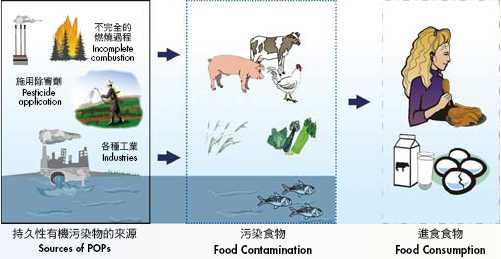
Food Safety Focus (22nd Issue, May 2008) – Food Safety Platform
Persistent Organic Pollutants in Food – An Overview
Reported by Miss Joan YAU, Scientific Officer,
Risk Assessment Section, Centre for Food Safety
From the "Belgium Dioxin Crisis" happened almost a decade ago that unusually high level of dioxins was found in dairy and poultry products in Belgium , to the recent food incident on dioxins contamination of mozzarella cheese in Italy , concerns over toxic contaminants in food have been raised from time to time. Dioxins, in fact, belong to a group of organic contaminants, namely "Persistent Organic Pollutants (POPs)", that are persistent in the environment and pose significant threats to human health and the environment. In this issue of the Food Safety Platform, we would present an overview of POPs and in the next issue their food safety implication.
What are POPs?
POPs are organic compounds that were used as pesticides and industrial chemicals, or are by-products of human activities. By definition all of these chemicals share four properties:
- highly toxic (i.e. may cause cancer, damage to reproductive and immune systems in humans and animals);
- persistent (i.e. lasting for years or even decades before degrading into less dangerous forms);
- transport long distances in the atmosphere, resulting in widespread distribution across the earth including regions where they have never been used; and
- accumulate in fatty tissue of living things (i.e. eliminated from the body very slowly).
Why are POPs Present in Food?
Owing to their special characteristics, POPs can be present anywhere in the world, accumulate in the fatty tissue of living organisms and gradually concentrate as organisms eat others as they move up the food chain. Their levels can be magnified up to many thousands of times higher than background levels in the fatty tissues of organisms at the top of the food chain, such as fish, predatory birds and mammals. Foods of animal origin, i.e. meat, poultry, fish, egg, milk and their products, are likely to have higher levels of POPs.
Illustration: How POPs ended up in food
What have been Done in the International Arena?
In 2001, the world's governments adopted an international treaty, namely the Stockholm Convention on Persistent Organic Pollutants , which aims at restricting and ultimately eliminating the production, use, release and storage of POPs. Twelve POPs of the greatest concern have been identified. These 12 POPs include:
- Certain pesticides: e.g. DDT and chlordane were once used to control pests in agriculture and environment. Their applications had been banned, except for DDT with restricted use to control malaria-bearing mosquitoes in several countries.
- Industrial chemicals: e.g. polychlorinated biphenyls (PCBs) had been employed in industries as heat exchange fluids, in electric transformers and capacitors, and as additives in paint, carbonless copy paper, sealants and plastics.
- Unintentional chemical by-products of industrial processes and other human activities: e.g. dioxins and furans are produced unintentionally due to incomplete combustion, the manufacture of certain pesticides and other chemicals, as well as pulp and paper bleaching, etc.
Diet has been considered as the major route of POP exposure for the general population. We would talk about the potential food safety implication of POPs in the next issue.
《斯德哥爾摩公約》定出的 12 種持久性有機污染物
The 12 POPs under the Stockholm Convention
| 持久性有機污染物 POPs |
除害劑 Pesticide |
工業化學物 Industrial chemical |
無意產生的化學副產品 Unintentional chemical by-product |
|---|---|---|---|
| 艾氏劑 Aldrin |
 |
||
| 氯丹 Chlordane |
 |
||
| 滴滴涕 DDT |
 |
||
| 狄氏劑 Dieldrin |
 |
||
| 二噁英 Dioxins |
 |
||
| 異狄氏劑 Endrin |
 |
||
| 呋喃 Furans |
 |
||
| 七氯 Heptachlor |
 |
||
| 六氯代苯 Hexachlorobenzene |
 |
 |
 |
| 滅蟻靈 Mirex |
 |
||
| 多氯聯苯 Polychlorinated biphenyls (PCBs) |
 |
 |
|
| 毒殺芬 Toxaphene |
 |



